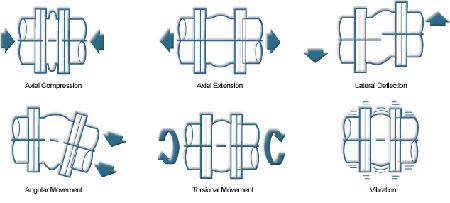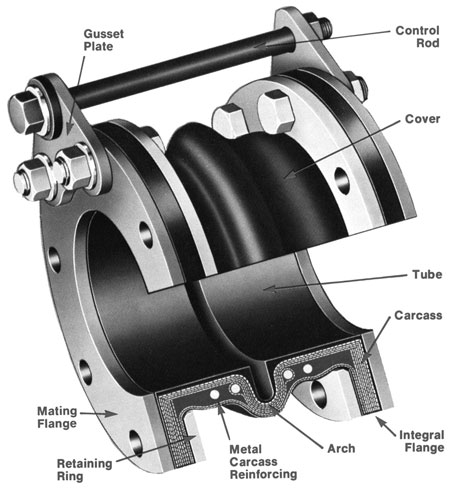Elastomeric expansion joints serve many functions in modern piping systems including absorbing all directional movements, reducing noise and vibration, resisting shock, relieving pipe and anchor stresses, compensating for misalignment and providing access to piping and equipment. Many of these functions are not accomplished with alternative methods like metallic expansion joints or expansion loops. Unfortunately, expansion joints in general can be misapplied with serious consequences. A reliable piping system requires an understanding of both the expansion joint's basic functions and the overall piping system's requirements.
Functional Capabilities
The main purposes of an elastomeric expansion joint are to reduce noise and vibration and accept all directional thermal movements. They reduce noise and vibration by creating a discontinuity between pipe materials. Any rotating equipment, such as a centrifugal pump, will create noise and vibration via unbalanced forces. The frequency and amplitude of vibration depends on the pump's speed and type. The elastomeric expansion joint acts to attenuate these disturbing frequencies and absorb the energy. This minimizes the transmission of noise, vibration and stresses into the adjacent piping or equipment.

Figure 1. Absorbs all directional movement and vibration
The flexible body of an elastomeric expansion joint also accepts the piping thermal movements in all directions (see Figure 1). Thermal movements are an important consideration in any system design. Depending on the temperature change, material and pipe length, thermal movements can be large enough to generate forces that can quickly exceed allowable pipe stresses. Expansion joints allow movement in the compression, extension, lateral, torsional and angular directions and absorb the thermal stresses.
Elastomeric expansion joints are also widely used because of their excellent resistance to shock and wear.Shock and bending loads are generated in piping systems from water hammer, pressure surges and seismic events. Expansion joints work as shock absorbers to accept these forces and displacements and protect the system from damage. In addition, the elastomeric material provides excellent resistance to wear and cyclic loading, particularly compared to its metallic counterparts.
It is common in both new construction and replacement applications to encounter pipe misalignment. The elastomeric expansion joint compensates for misalignment and provides access to piping and equipment. The development of synthetic elastomers and fibers has enabled the product to be designed to handle pressures of 350 psi and temperatures of 400 deg F-conditions that would have previously prohibited the use of non-metallic materials.

Figure 2. Spool Type Expansion Joint Construction
Construction
An elastomeric expansion joint typically consists of the tube, carcass and cover (see Figure 2). The tube is
a leak-proof lining that protects the carcass from contact with the fluid medium. The tube material is
selected to withstand the fluid's temperature, chemical and abrasive characteristics. Chemical resistance guides are useful in selecting elastomeric materials compatible with the process fluid. A full range of materials are available including chlorobutyl, nitrile, chloroprene, EPDM, chlorosulfonated polyethylene and fluoroelastomers, as well as PTFE.
The carcass is designed to handle the system's fluctuating movements, pressures and temperatures.Typically, multiple plies of rubber-impregnated polyester or aramide tire cord are used in conjunction with steel reinforcement to achieve the necessary strength. The resilient arch is primarily designed to handle the required flexibility, but it also has to withstand the required temperature and pressure. The steel rings at the arch's base are particularly important to prevent arch broadening from the continuous pressure. Arch broadening or migration can result in premature joint failure.
The cover, like the tube, acts to protect the carcass. The cover material is selected for its resistance to chemicals, oil, sunlight, acid fumes or ozone contamination, depending on the environmental conditions.
Design Types and Arrangements
There are many expansion joint types and arrangements that perform specific system functions. In retrofit offset applications, field measurements are often taken for the design and fabrication of custom-built expansion joints. More typical arrangements include straight spool pieces, both single and multiple arched; reducing joints, both eccentric and concentric; and simple sleeve types and flanged hoses.
Control Rods
It is important to use control rods to protect the expansion joint when the piping system is not adequately anchored. Pressure forces can quickly stretch the joint beyond its allowable limit and cause failure. This can be avoided with control rods set with clearances within the allowable movement limit of the joint. Control rods cannot protect the expansion joint from thermal movements that exceed the design criteria of the expansion joint when the pipeline is fully anchored.
Thermal forces are considerably greater than the control unit's strength because the cross-section of the steel pipe is greater than that of the control rods. If the pipe thermally contracts beyond the expansion joint's allowable expansion limit, both the control unit and the expansion joint will fail. This type of failure is often incorrectly attributed to manufacturing defects in material or workmanship, but it is actually caused by over-extension. Careful attention must be given to selecting an expansion joint that will accommodate the predicted thermal movements.
Conclusion
The primary functions of elastomeric expansion joints include absorbing all directional thermal movements and reducing noise and vibration. They are also used to resist system shock, relieve pipe and anchor stresses, compensate for misalignment and provide access to piping and equipment. With a basic understanding of both the expansion joint functions and the requirements of the overall piping system, a reliable piping system can be obtained. Consultation with a reputable expansion joint manufacturer is also beneficial in the design and selection process.
For more information on this topic, see the newly published FSA Technical Handbook Non-Metallic Expansion Joints and Flexible Connectors - Seventh Edition.
Next Month: What are the most energy efficient pump packing environmental control systems?
We invite your questions on sealing issues and will provide best efforts answers based on FSA publications.
